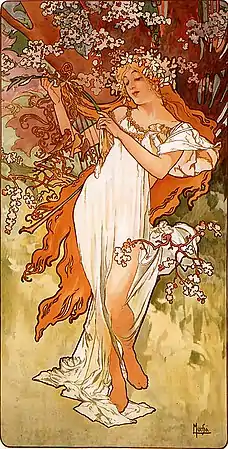Antheia
Antheia (Ancient Greek: Ἀνθεία) or Anthea is one of the Charites, or Graces, in Greek mythology and the goddess of swamps and flowery wreaths. She is the daughter of Zeus and Eurynome. She was depicted in Athenian vase painting as one of the attendants of Aphrodite.[1]

Mythology
Her name Antheia is derived from the Ancient Greek word ἄνθος means "flower" or "blossom". Her symbols are gold colored items. She was known to the Romans as Anthea. Her center of worship was on the island of Crete. The name Antheia was also given to Hera and connected to the Horae,[2] under which she had a temple at Argos.[3] It was also an epithet of Aphrodite at Knossos.[4][5] She was the goddess of vegetation, gardens, blossoms, especially worshipped in spring and near lowlands and marshlands, favorable to the growth of vegetation. She was also the goddess of human love. Her symbols are gold-colored items like honey and myrrh. [6]
Antheia is also the Greek name of Ancient Sozopolis in modern Bulgaria, and another Antheia was a village that was later adapted into Patras around 1000 BC.
Notes
- "Kharities". Theoi Project. Retrieved 2013-12-29.
- Joan V. O'Brien (1993). The Transformation of Hera. p. 139.
- Pausanias, Description of Greece ii. 22. § 1.
- R. F. Willetts (1977). The Civilization of Ancient Crete. University of California Press. p. 209.
- This article incorporates text from a publication now in the public domain: Chisholm, Hugh, ed. (1911). "Aphrodite". Encyclopædia Britannica (11th ed.). Cambridge University Press.
- Ramesh Chopra (2005). Academic Dictionary Of Mythology. p. 28.